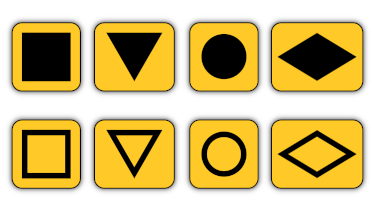A & C Driving School
Motorway Driving
When you are driving on a motorway
You must drive ahead. You are not allowed to turn or reverse. It is an offence to drive against the flow of traffic on a motorway.
If you find yourself driving against the flow of traffic, pull in immediately to the hard shoulder and stop. Contact the gardaí by dialing 999. Do not attempt to turn your vehicle. Wait for help in a safe place.
Drive at a safe and legal speed that will not interfere with traffic already on the motorway.
Keep a safe distance from the vehicle in front. Leave a bigger gap when you are driving on wet or icy roads or in fog.
Variable messaging warning signs may be used to advise motorists of potential hazards on the motorway. Do not stop or park on the
motorway except in an emergency or when you are told to do so by the emergency services or gardaí.
You must not drive on the hard shoulder as it is a motoring offence to do so and you could get penalty points.
- Always be careful and pay attention when you join a motorway.
- Build up speed on the acceleration lane before merging with motorway traffic.
- Signal in good time to make sure other motorway users know you intend to join the motorway traffic.
- As you approach the motorway on the slip road, check your mirrors and your blind spot for a safe gap in the traffic.
- Give way to traffic already on the motorway.
- Change your speed to fit safely and legally into the traffic (lane1). Stay in the slip road if it continues as an extra lane on the motorway. Avoid crossing a solid white line that separates the traffic lanes.
- Stay in the left-hand lane (lane1) long enough to adjust to the speed of traffic before you consider overtaking
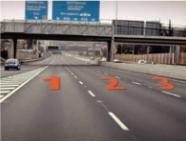
|
Motorway
|
There is an entrance to a motorway ahead and the road users listed on the sign must not enter the motorway. |
|
Entry to
|
The road user is now entering a motorway and must obey motorway rules. The sign usually appears beside the ‘Motorway ahead’ sign. |
|
Countdown
|
The driver is 300 meters from the next exit off the motorway. |
|
Countdown
|
The driver is 200 meters from the next exit. |
|
Countdown
|
The driver is 100 meters from the next exit. |
|
Motorway ends
|
There are 500 meters to the end of the motorway. |
|
End of
|
The driver has reached the end of the motorway. |
When you are leaving a motorway
You will normally leave the motorway by a slip road to your left, unless signs say that a lane leads directly off the motorway.
You should watch out for the signs below that let you know that you are getting near your exit. Move safely into the left-hand lane or lane 1 well before reaching your exit.
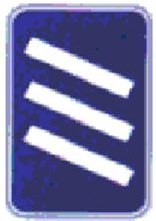
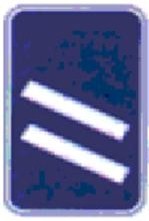
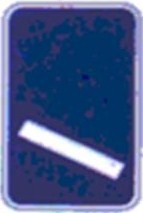
When you leave the motorway or use the link road between motorways, your speed may be much higher than you think. Check your speedometer and slow down as some slip roads have sharp bends.
When you leave the motorway, or it comes to an end, you will see the signs below.
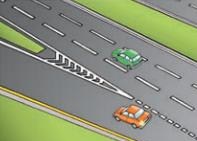
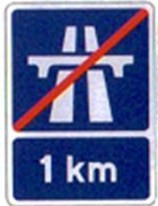
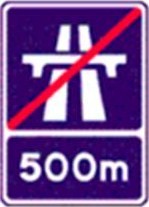
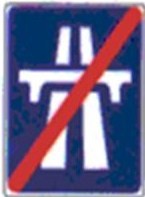
• Once you are on the motorway, you must signal before every lane change.
• Check your mirrors regularly, as you must always be aware of what is going on around you.
• Know the blind spots on your own and other drivers’ vehicles. Observing and scanning ahead of the vehicle in front of you can help you to avoid unnecessary braking.
• Remember, before changing lanes follow the ‘mirror, signal, mirror, manoeuvre’ method. Traffic may be coming from behind you at speed so remember to check your mirrors to help you judge how fast they are approaching. This will increase your chances of seeing a vehicle that is travelling in your blind spot.
Dublin Port tunnel
The Dublin Port tunnel connects the M1 (south of Dublin Airport) to the docklands. Specific road safety issues apply when you are approaching, driving through or leaving the tunnel.
Using the tunnel
• Check your fuel before entering the tunnel.
• Take off your sunglasses.
• Switch on your dipped headlights.
• Tune into any FM radio station to hear safety instructions in case of an incident.
• Keep a safe distance from the vehicle in front of you.
• Obey the speed limit.
• Do not stop except in an emergency.
• Do not turn or reverse.
If you breakdown or are in a collision
• Switch on your hazard warning lights.
• Switch off your engine and leave your key in the ignition.
• Go to the emergency station. Use the emergency phone to contact an operator.
• Obey operator instructions on FM radio and electronic signs.
• If your engine is on fire, switch off your engine and leave the vehicle immediately.
If there is a fire in the tunnel
• If there is smoke or fire behind you, drive out of the tunnel.
• If there is smoke or fire ahead, stop your vehicle, turn off the engine, leave the key in the ignition, leave your vehicle immediately and exit the tunnel by the nearest pedestrian exit.
If you are instructed to stop in the tunnel
• Switch on your hazard warning lights.
• Keep a safe distance between vehicles.
• Switch off your engine and leave your key in the ignition.
• Obey operator instructions on FM radio and electronic signs.
• If instructed to exit the tunnel, go to the nearest exit which will be indicated by distance on the wall.
FOLLOW THE SYMBOL TO RE-JOIN THE MOTORWAY
In the event of motorway collision, the Gardaí will close the road at the previous junction and traffic will be forced off the motorway.
The diversion signs will direct motorists to follow a particular symbol which will allow the driver to re-join the motorway at the next junction.
The diversion routes are selected so that all types of vehicles can use the suggested detour. For example, roads which involve bridges would only be selected if large trucks would be able to pass underneath.
The road network tends to favour solid black shapes placed on yellow backgrounds. However, where there is a large number of diversion routes in one location, there may be diversion signs that use hollow symbols. In total, there can be eight variations.
Motorists familiar with the M50 will have seen the symbols beside junctions around Ballymun, Finglas, Blanchardstown, Lucan, Red Cow and Sandyford. Transport Infrastructure Ireland liaises with the relevant Local Authorities when considering introducing new diversion routes.
